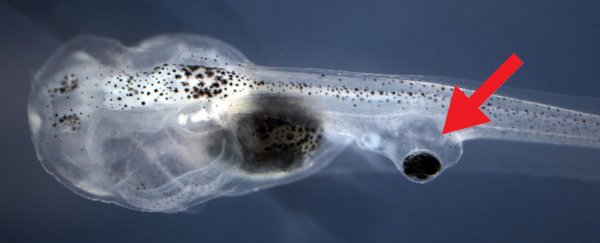Scientists have restored vision to blind tadpoles by surgically implanting eyes onto their tails, and treating the augmented animals with a drug that boosts nerve growth.
While the gruesome transplant procedure sounds a little like the work of mad scientists, the technique could help pave the way for using complex bioengineered organs in humans – especially since the drug involved is Zolmitriptan: a compound that activates serotonin receptors and is already used to treat migraines.
"The brain is remarkably plastic," biologist Michael Levin from Tufts University told Mindy Weisberger at Live Science.
"A tadpole brain, evolving for eons to expect visual input from the standard eye locations, has absolutely no problem picking up visual data from a weird new location on its back. This means that the brain can map its behavioural programs onto new body architectures, and this will be useful in the future."
The research is important because it tells us more about how nerves from transplanted organs can be used to connect with the central nervous system. As such, the findings could impact everything from organ transplants to learning how nerves can regenerate after injury.
But a word of warning – the process does involve some pretty grotesque and cruel-sounding procedures conducted on tadpoles.
With that said, to see just how malleable the tadpole sensory system is, Levin's team took early-stage tadpoles at just three days of age, removed their eyes, and cut narrow slits in their tails. Into these slits they then grafted eyes from other three-day-old tadpoles.
"These are embryos, so they are Play-Doh consistency," one of the researchers, Douglas Blackiston, told Eric Boodman at Stat.
"It all just heals together, the wound is invisible within 10 to 15 minutes. You can't even see where you've done the surgery."
The team had performed this kind of procedure before, restoring partial vision to blind tadpoles via tail implants back in 2013.
But this time they went further, to see if the neurotransmitter drug Zolmitriptan could help boost the acuity of the visual signal, by promoting innervation – the degree of nerve functioning and distribution – between the implanted eye and the tadpole's central nervous system. Turns out, it did.
In a colour test where tadpoles were trained to avoid swimming in areas with a red light, most healthy tadpoles did fine, with 76 percent passing the test, whereas only 3 percent of blind tadpoles passed.
Tadpoles with eye grafts did okay (11 percent passing), but among tadpoles with eye grafts and the Zolmitriptan treatment, 29 percent passed the test – evidence that the compound boosted neural connections around the implanted eyes.
In another optical test where the tadpoles had to respond to rotation patterns, the Zolmitriptan-treated individuals again scored significantly higher than untreated tadpoles with eye grafts.
What's remarkable about the results is that the tadpoles were able to see so well given that the eyes had no direct neural connections to the animals' brains – only to the central nervous system.
"The fact that the grafted eyes in our model system could transmit visual information, even when direct connections to the brain were absent, suggests the central nervous system contains a remarkable ability to adapt to changes both in function and connectivity," Blackiston explains in a press release.
Of course, given the highly experimental nature of this research and the fact that at present the effects have only been demonstrated in baby frogs, we're a long way from being able to accurately speculate on how these results might be replicated in humans.
That said, the team remains optimistic.
"If a human had an eye implanted on their back connected to their spinal cord, would the human be able to see out of that eye? My guess is probably yes," Levin told Jessica Hamzelou at New Scientist.
While that scenario is probably a fair way off (we hope), what's promising is that these findings suggest that complex implanted organs – such as eyes and ears – don't necessarily have to be stitched to the brain in order to provide sensory input.
Given there's a heck of a lot we still don't understand about how the brain works – let alone how to jack new artificial or transplanted organs into it – that's a definite plus for new kinds of medical treatments that could be developed in the future.
"We have no idea how we would connect a retina to the brain, and if you wanted to replace an ear, you would have to cut out a big piece of the skull," biologist Bernd Fritzsch from the University of Iowa, who wasn't involved with the study, told New Scientist.
"This work suggests that this might not be necessary – that you could put the organ on the neck, for example, and connect it to the spinal cord. It might look funny, but it could still work."
The findings are reported in npj Regenerative Medicine.
